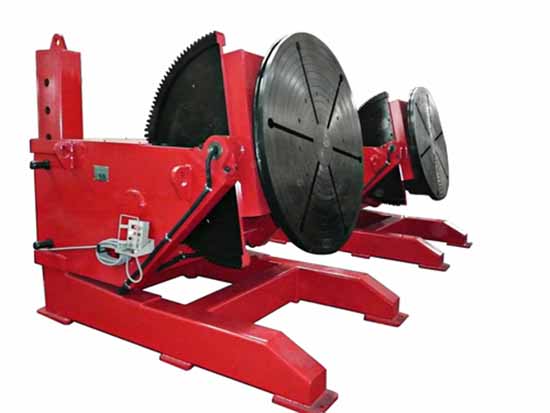
E-mail:sales@chinaolivet.cn

The basic forms of commonly used manual welding positioners are outrigger, tilt-turn and double-post single-turn. Due to the limitation of the degree of freedom of rotation, these kinds of positioners cannot realize the arbitrary rotation of the workpiece to be welded in space, so the various types of welding seams cannot be rotated to the optimal position required. The following introduces the selection of welding positioners and the types of commonly used positioners.
1. Significance of using welding positioner for construction machinery structural parts
Most of the structural parts of construction machinery such as bulldozers, excavators, and rollers are complex and are the main key components of the whole machine. The quality of its welding directly affects the performance of the machine. Selecting a suitable welding positioner can improve welding quality and production efficiency, reduce labor intensity and production costs of workers, strengthen safe and civilized production, and is conducive to on-site management.
2. Selection of welding positioner for structural parts
(1) Select a suitable welding positioner according to the characteristics of the welding structure.
For example, bulldozer rear axle box and excavator X frame can use L-type double rotary welding positioner, bulldozer frame can use roller frame welding positioner, excavator bucket welding positioner can be designed as C-type double rotation type The excavating manipulator can be used with a double-pillar single-slewing positioner.
(2) Selection according to the situation of manual welding
The selected welding positioner can transfer any one of the welded workpieces to the flat welding or ship welding position, avoiding vertical welding and overhead welding, and ensuring the welding quality.
(3) Selection according to operation needs
Choose a welding positioner with good openness, easy operation, compact structure and small footprint, and the workers' operating height is as low as possible, safe and reliable. The design of the tooling should consider the simple and convenient clamping of the workpiece.

Heavy Duty Welding Positioner
(4) Selection of large structural parts
The heavy duty welding positioner of construction machinery has a very high welding operation, and workers can perform welding by stepping up. It can also be equipped with a hydraulic lifting platform to facilitate welding at different height positions.
3.Several common positioner structures used by Shantui construction machinery structural parts
(1) Double-pillar single-rotation welding positioning machine
This type of positioner is suitable for welding rectangular structural parts of engineering machinery such as excavating motor arms and roller frames. Its main feature is that one end of the column motor drives the working device to rotate in one direction of rotation, and the other end follows the driving end. The uprights on both sides can be designed to be liftable to suit different specifications. The disadvantage of this positioner is that it can only be rotated in one circumferential direction. When selecting, pay attention to whether the weld seam is suitable.
(2) Double seat head and tail double rotary welding positioning machine
Compared with the first positioner, the structure to be welded has another degree of freedom in rotation in another space. This type of positioner has a large welding space, the workpiece can be rotated to the required position, and the design is advanced. It has been successfully used in many manufacturers of construction machinery.
(3) L-type double-rotation welding positioning machine The working device of this type of positioner is L-type, which has two degrees of freedom of rotation, and both directions can be arbitrarily rotated by 360 °. Compared with other types of positioners, this positioner is more open and easy to operate. The L-type positioner was successfully used in the welding of the rear axle box of the bulldozer, and the use effect was very good, which was welcomed by the field operators.
(4) C-type double rotary welding variable positioning machine The C-type rotary type is the same as the L-type machine, but to facilitate the specific design of the clamp. According to the shape of the structural part, the working device of the positioner is slightly changed. This type of welding positioner is suitable for welding the bucket of a loader and the bucket of an excavator. .
4. Development trend of welding positioner
Robots are generally used for welding large-scale structural parts in foreign countries. From the current status of domestic technology and equipment investment, it is not mature to completely replace manual welding operations with welding robots. However, if there is no welding positioner, it is impossible to manually adjust some vertical welds and overhead welds in complex structural parts to the flat or ship welding position that is easy to weld. In addition, most structural parts of construction machinery are very irregular, such as the rear axle box of the bulldozer, the trolley frame, and the boom of the excavator. The welds are complex, the shape is large and the weight is heavy. Not only frequently occupying hoisting equipment, low welding efficiency, but also extremely difficult on-site operation, there are certain safety risks, but these problems can be effectively solved using welding positioners. For this reason, with the development of welding technology, it is believed that the application of welding positioners in construction machinery will become more and more common.
Wuxi OLIVET Machinery Equipment Co.,LTD.E-mail: sales@chinaolivet.cnTel: +86-510-8383 0908
Home About UsProductsQuality ControlCompany NewsContact Us Sitemap
Copyright©2015 Wuxi OLIVET Machinery Equipment Co.,Ltd. Technical Support: Reanod